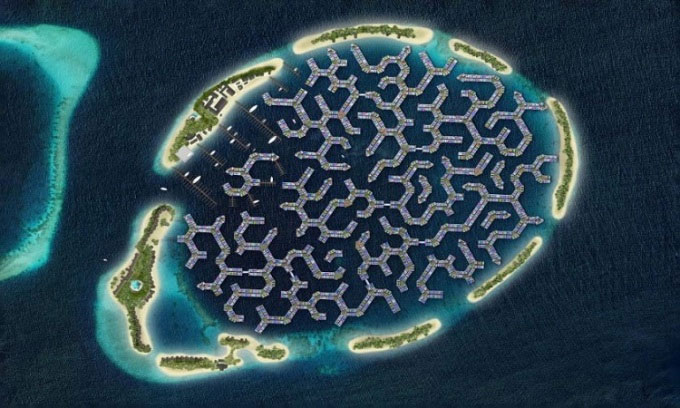The floating city of Maldives, located in the Indian Ocean, will provide shelter for tens of thousands of residents from the island nation threatened by rising sea levels.
In a turquoise lagoon just a 10-minute boat ride from Malé, the capital of Maldives, a new city designed to accommodate 20,000 people is under construction. With a design reminiscent of brain coral, the city will feature 5,000 floating units, including homes, restaurants, shops, and schools, interspersed with canals. The first floating units are set to be unveiled in June 2022, with residents expected to start moving in early 2024, and the city projected to be fully completed by 2027.

Design of the floating city of Maldives. (Photo: Waterstudio.NL/Dutch Docklands)
This project is a collaboration between the Dutch real estate developer Docklands and the Maldivian government to combat rising sea levels. As an archipelago of 1,190 low-lying islands, Maldives is one of the countries most vulnerable to climate change. Eighty percent of Maldives’ land area is less than one meter above sea level. If sea levels rise by one meter by the end of the 21st century as predicted, nearly the entire country could be submerged.
According to Koen Olthuis, the founder of Waterstudio, the architectural firm designing the floating city, this will be a new hope for over half a million Maldivians. The Maldives project aims to build a city for 20,000 residents in less than five years. Other floating city projects, such as Oceanix City in Busan, South Korea, and the floating archipelago in the Baltic Sea by the Dutch company Blue21, have been introduced previously but do not compare in scale and timeline.
The city designed by Waterstudio aims to attract local residents with its colorful homes, spacious balconies, and ocean views. Residents will commute by boat, walk, cycle, or use electric scooters along the streets. The project will offer significantly more space than Malé, one of the most densely populated cities in the world, with 200,000 people living in an area of 8 km2.
Modular units will be constructed in local shipyards and then towed to the floating city. Once in place, they will be anchored to underwater concrete pillars, secured to the seabed with steel rods. The coral reefs surrounding the city will provide a natural wave barrier, stabilize the structures, and prevent residents from experiencing seasickness. According to Olthuis, local coral experts have thoroughly assessed the potential environmental impact of the project, and authorities have approved the design before construction begins. To support marine life, artificial shorelines made from glass foam connected to the city’s foundations will encourage coral growth.
The goal for the city is to be self-sufficient, functioning like a city on land. The primary power source will be solar energy generated on-site. Wastewater will be treated and reused as organic fertilizer for crops. To replace air conditioning, the city will utilize deep-sea cooling methods, pumping cold water from the deep sea into the lagoon, contributing to energy savings.


















































